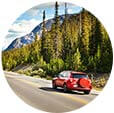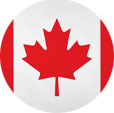This year is Canada’s 150th birthday, and like all big birthdays there is a strong spirit of celebration and giving. With this in mind, Canada has made all of its national parks free for the entire year. This is an incredible gesture, but it also makes life difficult when choosing between so many fantastic and diverse landscapes to visit!
As the world’s second largest country by area, it encompasses many different terrains and hosts some incredible wildlife. Canada also makes the most of its natural wonders and climate by embracing outdoor activities. So no matter what you are looking for, you’ll definitely find it in one of these diverse national parks on your Canada Holiday.
Thousand Island National Park, Ontario

This is the national park for those who feel in their element in water. It is characterised by rocky granite outcrops, shimmering blue waterways and windswept pines. A paradise for canoes and kayaks, the best way to see this national park is on the water. By embracing this element of Thousand Islands, you can see how much wildlife the national park has to offer, as rare turtles and an enormous variety of birdlife reside in this picturesque destination.
The islands here range from 40 square miles to a couple of square feet. To qualify as an island at the national park, it must have at least one square foot above water all year round and support living trees. Heart Island, pictured above, houses Boldt Castle and sits in the American part of the park.
Fundy National Park, New Brunswick

Fundy National Park encapsulates much of the Bay of Fundy and the incredible coastline that is famed for its monstrously high tides. While at low tide, you can explore the depths of the ocean floor with shellfish clinging to the rocks, this soon disappears under 15 metres of sea water at high tide. This national park is not all coastal though – with 25 hiking routes, you can see all sorts of flora and fauna, including a primrose that can only be found in Fundy National Park.
If you’re looking for something a little different, here you have the option of staying in a yurt as opposed to the usual campsite affair. So if you are looking for a little wilderness that doesn’t come at the expense of comfort, then this may be the perfect choice.
Banff National Park – Alberta

Banff is famed for its outdoor sports. Whether it is skiing in the winter or mountain biking in the summer, this is a park that is all about adrenalin, with some stunning views and diverse scenery thrown in. Canada’s first national park all began with the discovery of the Banff Upper Hot Springs and the continuation of the Canadian Pacific Railway. Even today, it’s the perfect spot to indulge in some spa therapy, particularly at the iconic Fairmont Banff Springs Hotel.
Of course, the national park is home to some of Canada’s most iconic lakes, like Moraine Lake in the Valley of the Ten Peaks and the glacial turquoise Lake Louise. Banff National Park overlaps with the Columbia Icefield, which is the largest icefield in the Rocky Mountains. At about 125 square miles it joins Banff national park with Jasper National Park. You can drive between the two along the stunning Icefields Parkway and even stop off for a tour of the Athabasca Glacier.
Pacific Rim National Park – British Colombia

The park is made up of three different areas and each offers a unique experience and gorgeous scenery. While Long Beach is the most visited area of the park due to accessibility, it encapsulates a lot alongside the 22km beaches it is named for. From trails offering glimpses into some of Canada’s First Nations to a beachcomber’s paradise, Long Beach has activities alongside the 94 campsites that have made it so popular. The mix of landscapes also makes it naturally diverse and interesting, offering temperate rainforests, bogs and coastal elements.
The Broken Group Islands are comprised of over one hundred little islands and islets, seven of which allow back country camping. Kayaking around the area is on many adventure bucket lists, including National Geographic’s. While less visited, this allows the Broken Group Islands to play a host to some of Canada’s incredible wildlife, allowing you to spot bald eagles, whales and sea lions.
The West Coast Trails often ranks as one of the world’s top hikes. Initially created to help shipwreck survivors, this trail is a wonderful experience for anyone interested in eco-tourism due to a unique opportunity offered by the Ditidaht First Nation Community that resides there.
Gros Morne National Park – Newfoundland

If you are looking to experience lots of different terrains, then this is surely the national park for you. Gros Morne National Park is named after the second highest mountain in Newfoundland and the highest peak within the park. Gros Morne officially means ‘Great Mountain standing alone’ but more literally translates as ‘Great Sombre’. Apart from the rather grim name Gros Morne offers almost every imaginable landscape alongside stunning fjords. While the adventurous can hike to alpine highlands and spot arctic hare among the tundra, those who prefer a more relaxed excursion, the colourful seaside villages nearby offer a bright and leisurely alternative.
Aside from the fact that Gros Morne is a UNESCO World Heritage site, it also contains some incredible features including Pissing Mare Falls which is the highest waterfall in Eastern North America.
Auyuittuq National park- Nunavut

Auyuittuq roughly translates as ‘the land that never melts’ and unsurprisingly is made up of artic terrain including glaciers and icefields. While there is a limited amount of vegetation and wildlife is scarce, what is there is worth seeing. Arctic foxes and hares can just be seen despite their camouflage, and the skies are stalked by peregrine falcons and snowy owls. The deep waterways are home to beluga wales, narwhales and ring seals. Of course, the wildlife everyone is most eager to see are the wolves and polar bears.
Auyuittuq National Park is severe during the winter months, but in March, polar bears can be seen with their cubs and during the summer months you can cross into the Arctic Circle. When heading into the park, there are very few signs of civilisation, it is a wilderness left almost untouched and is perfect for anyone looking for an escape. Spend the nights spotting the Northern Lights and the days revelling in the haunting beauty of the landscape.
There is a cultural element to the park which makes it a must visit, as it is strongly influenced by the local Inuit community. Learning about their culture and history truly brings another element to any vacation this far north.
Image credits: James Wheeler (Flickr) / Golden Shrimp (Shutterstock) / Dlanglois (Wikimedia Commons) / Juan Alberto Garcia Rivera (Flickr) / Kevin M Klerks (Flickr) / Ansgar Walk (Wikimedia Commons)







